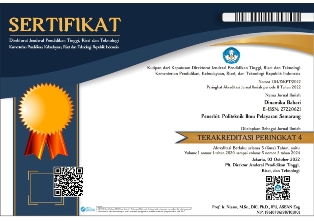Analysis of Floating Mooring Buoy as Platforms at Sea
Abstract
Analysis of the buoyancy of this platform for use in mid-ocean land survey operations where this platform is loaded with the weight of the tools and workers on the platform. The purpose of this research is to describe the buoyancy of the mooring buoys. The research was conducted by calculating the capacity and weight of each material used and the buoyancy of the buoy to be used as a platform for land surveys in mid-ocean, the ability of seawater to shift the size of the pontoon to be used as a platform and calculate the load on the pontoon itself to obtain the buoyancy value of the pontoon. The ability of the strapping between the pontoon and the anchor was calculated to anticipate unstable pontoon motion and must have a stress capability that exceeds the stress experienced when the pontoon is hit by a wave. The tension in the chain is greatest force is assumed, namely the force of the ballast. When the earthworks pontoon capacity is used as mooring buoy by estimating the total weight of the earthworks pontoon capacity, it is still in a semi-floating condition, although under certain conditions it will drop to as much as 95% of the estimated buoyancy pressure capacity of the mourning buoy.
Downloads
References
Barbanti, G., Marino, E., & Borri, C. (2019). Mooring system optimization for a spar-buoy wind turbine in rough wind and sea conditions. In Proceedings of the XV Conference of the Italian Association for Wind Engineering: IN-VENTO 2018 25 (pp. 87-98). Springer International Publishing.
Barrera, C., Losada, I. J., Guanche, R., & Johanning, L. (2019). The influence of wave parameter definition over floating wind platform mooring systems under severe sea states. Ocean Engineering, 172, 105-126.
Boo, S. Y., & Shelley, S. A. (2021). Design and Analysis of a Mooring Buoy for a Floating Arrayed WEC Platform. Processes, 9(8), 1390.
Boo, S. Y., Kim, H., Shelley, S. A., & Kim, D. (2018, February). Preliminary design and analysis of mooring buoy for an arrayed WEC platform. In SNAME 23rd Offshore Symposium. OnePetro.
Boo, S. Y., Kim, K. H., Lee, K., Park, S., Choi, J. S., & Hong, K. (2016, February). Design challenges of a Hybrid Platform with multiple wind turbines and wave energy converters. In SNAME 21st Offshore Symposium. OnePetro.
Figueroa-Lara, J. J., Murcia-Gonzalez, J. M., Garcia-Martinez, R., Romero-Romo, M., Rodriguez, M. T., & Mugica-Álvarez, V. (2019). Effect of platform subway depth on the presence of Airborne PM2. 5, metals, and toxic organic species. Journal of Hazardous Materials, 377, 427-436.
Ghafari, H., & Dardel, M. (2018). Parametric study of catenary mooring system on the dynamic response of the semi-submersible platform. Ocean Engineering, 153, 319-332.
Lat, D. C., Jais, I. B. M., Ali, N., Yunus, N. Z. M., Zarin, N. H. W. N., & Zainuddin, A. N. (2022). Consolidation integrated buoyancy equation for soft ground improved with lightweight polyurethane foam. IIUM Engineering Journal, 23(1), 1-12.
Li, J., White, P. R., Bull, J. M., & Leighton, T. G. (2019). A noise impact assessment model for passive acoustic measurements of seabed gas fluxes. Ocean Engineering, 183, 294-304.
Nair, M. A., Sofi, A., & Kannan, V. (2018). Extension of Existing Platform of Kochi Metro to Accommodate More Train-Cars. International Journal of Engineering & Technology, 7(3.6), 59-63.
Neisi, A., Ghassemi, H., Iranmanesh, M., & He, G. (2022). Effect of the multi-segment mooring system by buoy and clump weights on the dynamic motions of the floating platform. Ocean Engineering, 260, 111990.
Shao, G., & Li, Y. (2020). Numerical Simulation and Analysis of Electromagnetic Fields Induced by a Moving Ship Based on a Three-Layer Geoelectric Model. Journal of Ocean University of China, 19, 1299-1306.
Song, R., Zhang, M., Qian, X., Wang, X., Dai, Y. M., & Chen, J. (2016). A floating ocean energy conversion device and numerical study on buoy shape and performance. Journal of Marine Science and Engineering, 4(2), 35.
Weilgart, L. I. N. D. Y. (2018). The impact of ocean noise pollution on fish and invertebrates. Report for OceanCare, Switzerland.
Wüest, A., Bouffard, D., Guillard, J., Ibelings, B. W., Lavanchy, S., Perga, M. E., & Pasche, N. (2021). LéXPLORE: A floating laboratory on Lake Geneva offering unique lake research opportunities. Wiley Interdisciplinary Reviews: Water, 8(5), e1544.














